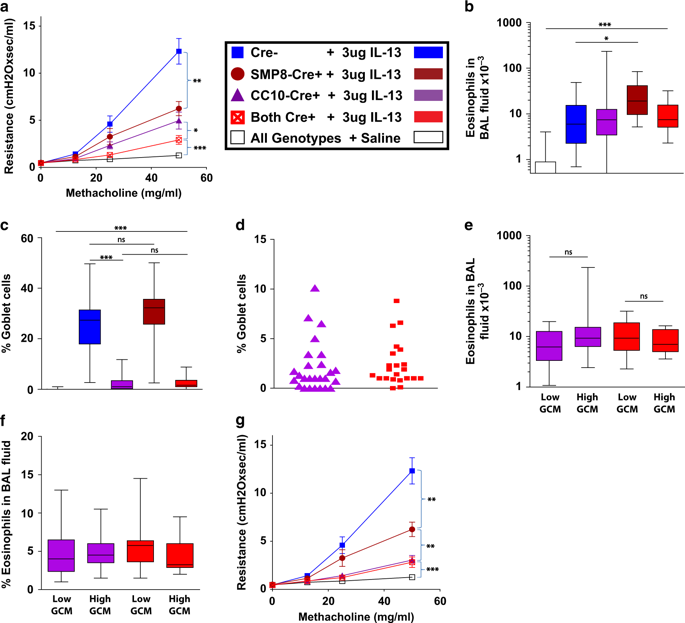Mucosal Immunology ( IF 7.9 ) Pub Date : 2019-11-19 , DOI: 10.1038/s41385-019-0232-7 Christopher G McKnight 1, 2 , Crystal Potter 2 , Fred D Finkelman 2, 3

|
Airway hyperresponsiveness (AHR) often defines asthma. Murine allergic airway disease (AAD), like human eosinophilic asthma, is characterized by AHR, eosinophilia, goblet cell metaplasia (GCM), smooth muscle hypercontractility, and increased production of IL-4 and IL-13—cytokines that induce these characteristics by binding to the IL-4Rα chain. We evaluated the epithelial and smooth muscle IL-4Rα-dependent contributions to AHR of BALB/c mice that possessed 0–2 functional IL-4Rα alleles and had airway disease induced by house dust mite extract (HDM) or exogenous IL-13. Two functional IL-4Rα alleles were required for maximal AHR, while only one functional allele was required for maximal GCM and systemic IL-4/IL-13 levels. Deletion of IL-4Rα from both smooth muscle and epithelial cells inhibited AHR >83% in mice with two functional IL-4Rα alleles. In mice with one functional IL-4Rα allele, selective epithelial cell IL-4Rα deletion maximally inhibited AHR, while selective smooth muscle IL-4Rα deletion decreased IL-13-induced, but not HDM-induced, AHR. Less IL-4Rα signaling is required to maximize the epithelial cell contribution to AHR compared to the smooth muscle contribution to AHR. In addition, epithelial cell responses to IL-4/IL-13 can increase the IL-4Rα-dependent smooth muscle contribution to AHR. These findings carry increasing relevance as IL-4Rα-targeted therapy is administered to human asthmatics.
中文翻译:

气道上皮和平滑肌表达的 IL-4Rα 几乎是小鼠过敏性气道疾病中所有气道高反应性的原因
气道高反应性 (AHR) 通常定义为哮喘。小鼠过敏性气道疾病 (AAD) 与人类嗜酸性粒细胞性哮喘一样,其特征是 AHR、嗜酸性粒细胞增多、杯状细胞化生 (GCM)、平滑肌收缩过度以及 IL-4 和 IL-13 细胞因子的产生增加,这些细胞因子通过结合诱导这些特征至 IL-4Rα 链。我们评估了 BALB/c 小鼠上皮和平滑肌 IL-4Rα 依赖性对 AHR 的贡献,这些小鼠拥有 0-2 个功能性 IL-4Rα 等位基因,并患有屋尘螨提取物 (HDM) 或外源性 IL-13 诱导的气道疾病。最大 AHR 需要两个功能性 IL-4Rα 等位基因,而最大 GCM 和全身 IL-4/IL-13 水平只需要一个功能性等位基因。在具有两个功能性 IL-4Rα 等位基因的小鼠中,从平滑肌和上皮细胞中删除 IL-4Rα 可抑制 AHR >83%。在具有一种功能性 IL-4Rα 等位基因的小鼠中,选择性上皮细胞 IL-4Rα 缺失最大程度地抑制 AHR,而选择性平滑肌 IL-4Rα 缺失则降低 IL-13 诱导的 AHR,但不会降低 HDM 诱导的 AHR。与平滑肌对 AHR 的贡献相比,需要较少的 IL-4Rα 信号传导来最大化上皮细胞对 AHR 的贡献。此外,上皮细胞对 IL-4/IL-13 的反应可以增加 IL-4Rα 依赖性平滑肌对 AHR 的贡献。随着 IL-4Rα 靶向治疗应用于人类哮喘患者,这些发现的相关性越来越大。











































 京公网安备 11010802027423号
京公网安备 11010802027423号